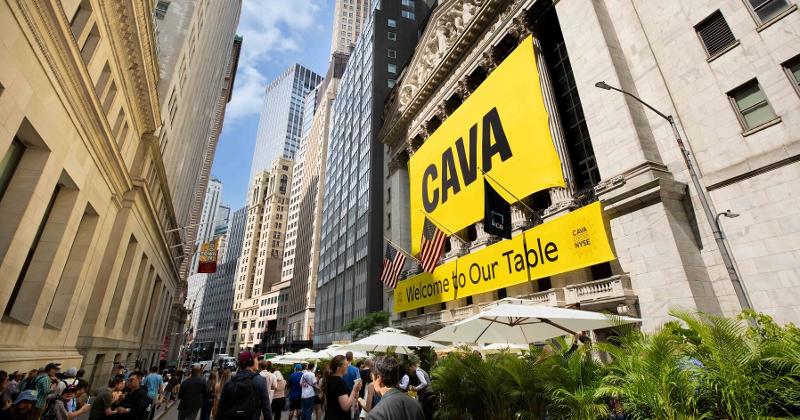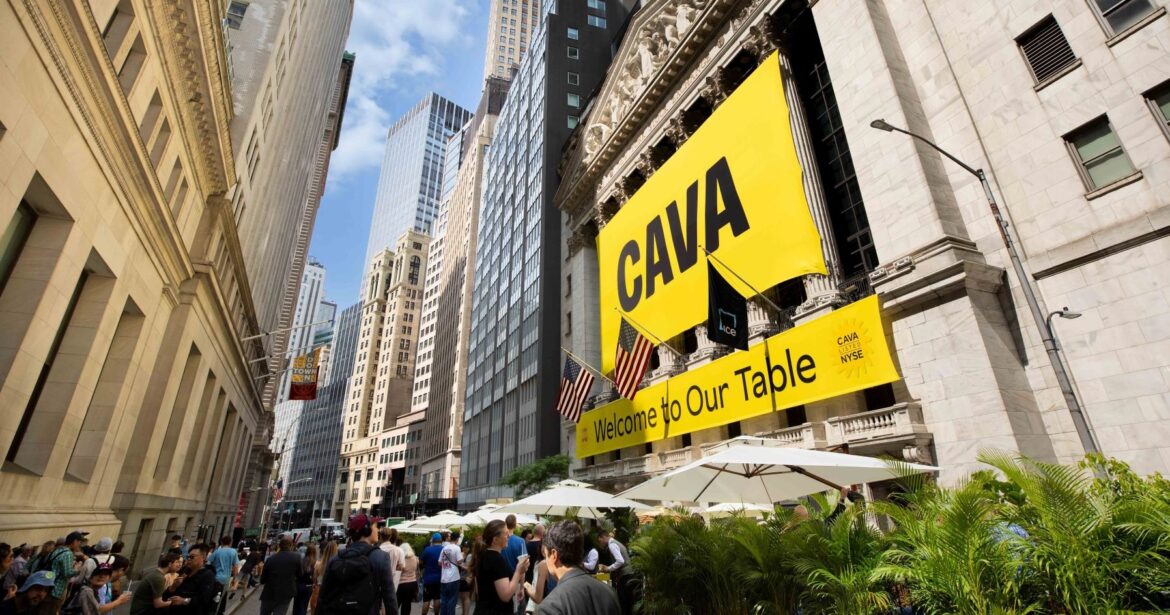
How Cava Grill funded its route to IPO in 2023. | Photo: Shutterstock.
Ike Grigoropoulos, Ted Xenohristos and Dimitri Moshovitis founded a full-service Greek restaurant called Cava Mezze in Rockville, Maryland, in 2006. Brett Schulman later joined the company to help it sell products in grocery stores, and by 2009 the founders asked him to become a fourth partner and he was named CEO.
In the years since then, Cava has become one of the most admired restaurant chains on Wall Street. While its stock has hit a rough patch this year, its shares have nearly tripled since its 2023 IPO and it has a market cap of $7.3 billion.
The journey over the past 18 years, however, speaks to the rough-and-tumble world of restaurant chain financing. Schulman detailed that journey to a group of emerging restaurant operators at the CREATE Conference in Nashville on Wednesday, telling a story of scratching and clawing, tough lessons and a bit of luck.
That story offers lessons for restaurant operators looking to finance their next step. “Listen,” Schulman said, “if you have a good product, you have a good brand, you’ve got a good team, money will typically find you.
“I think the bigger question, the bigger challenge is, who do you want to partner with? Because I’ve seen situations go the wrong direction when there was a misalignment of what the investors’ outcome or expectations were versus what the business owners’ expectations were.”
Scratching and clawing
The original three founders had already established a reputation in the local area with their first two restaurants, Schulman said. Fans of the restaurant had routinely asked them if they could invest in the concept. That gave them some credibility when the four of them decided to create a fast-casual version.
They got some of them together, presented the business plan and mocked up some of the food. “We spent the next three or four months scratching and clawing a lot of friends-and-family checks and checks from some of those customers and people we really networked with, really with the idea of funding two to three locations to prove out our thesis,” Schulman said.
They got a bank loan, signed the guarantees and raised more funds from family and friends to open two more locations. By the time Cava reached its fifth unit in 2013, they began getting phone calls from institutional investors.
An architect from Cava’s first restaurant introduced Schulman to someone for whom they designed an office, who turned out to be the managing partner for Swan & Legend, which would eventually become their venture capital partner, along with Revolution Growth. When Cava later decided to do an institutional round, Schulman said, those two firms proposed an offer.
They would be joined by a third investor, the private-equity firm Invus, in what would be a $45 million Series B investment. Invus had expressed interest in Cava early in the brand’s history, but typically does majority investments — something the founders weren’t interested in. Invus changed its mind two weeks before closing.
“That did two things,” Schulman said. “One, it created a really great, eclectic group of investors that all had deep pockets that could potentially fund future growth.” But they also wanted a “very vanilla structure,” Schulman said.
Rather than form multiple classes of stock with preferred dividends, there was only one class. A more complex structure might have pushed valuation, but it kept things “clean.” “The philosophy was that everybody would be holding hands in the same class of stock, so that when difficult decisions came down the pike, or we were faced with difficult choices for a financial raise, everybody’s aligned and in the same boat,” Schulman said.
Schulman wanted Cava to be something big, to establish Mediterranean as a legitimate category. It’s one that has always been loaded with potential, but none of the concepts could get far. Schulman said the investment structure gave the company the firepower to get the brand off the ground.
“I said to my partners, ‘Do we want potentially 10% of something incredible, or do we want 100% of something tiny, where that doesn’t work out?'” he said. “We felt like we wanted to establish this category, that we wanted to get clear leadership position in and being corporate owned … and be able to do it with operational integrity, and be able to hire the operators ahead of the growth versus waiting to be able to afford them.”
The Zoe’s Kitchen acquisition
Fast-forward to 2018. By then, Cava had 66 locations. The company had just raised more funds, and former Panera Bread CEO Ron Shaich was one of its investors. Shaich periodically met with Schulman over lunch and had served as a mentor.
One year at the Restaurant Leadership Conference — which, like CREATE, is operated by Restaurant Business parent company Informa Connect — Shaich approached Schulman with an idea: Buy Zoe’s Kitchen.
Zoe’s Kitchen had gone public in 2014, but it had run into problems and Shaich was brought in to help. Yet it was triple Cava’s size. That would be tough to swallow. But it would also give Schulman what he wanted, an “escape velocity,” or rapid growth to lead the Mediterranean sector.
“It goes back to that escape velocity,” he said. “We felt that scale was going to matter more than ever in the industry, that technology was a big driver between the haves and the have-nots.”
Cava acquired Zoe’s in a deal valued at $300 million, with investment from Shaich’s Act III Holdings along with its existing partners. The ultimate plan was to convert Zoe’s into Cavas, creating a big chain. It would be much cheaper to convert those locations, and they had great real estate that was in markets in the South where Cava wanted to expand.
But then 2019 happened. “I like to say I got a PhD in business that year,” Schulman said. Zoe’s struggles worsened that year, forcing management to focus on righting the business. Some people left. “I was like a 10th-grader and I had to be a grown-up adult overnight,” Schulman said.
He credited Cava’s board for guiding the company through the period. Members asked Schulman for five pillars that would turn around the business, and who would be responsible for them. They focused on those efforts, and it stabilized the business.
The conversion itself was unusual, particularly that it was a small company buying a bigger one. But it would transform Cava.
The Cava Group IPO
By 2021, Cava’s board looked at the IPO market, which was “wide open,” and asked Schulman if the company was ready. His answer? “No we’re not,” he said. “We just don’t feel like, operationally, we’re as consistent as we want to be. We don’t feel like internally and in the finance function, we were buttoned up.”
But the company began preparing anyway. Cava began doing mock earnings calls and wrote mock press releases. It hired a chief accounting officer and did an internal audit on its controls. It also improved operational performance. By 2022, with the Zoe’s conversions just about done, the company decided it was time. The company filed privately, and it went public in 2023. The stock rose as much as 117% on its first day.
Cava did one other thing to prepare itself for that day: It ensured it had a balance sheet to get it through tough times. “We felt we had the cushion to go public, that if a rainy day did come or business conditions got more difficult, that the short-term challenges or quarterly results would not unduly influence us into a very short-term, financially driven decision,” Schulman said.
That would prove prescient this year. A tough economic environment has taken some of the sheen off Cava’s results so far, resulting in a 44% decline in stock price. “Last quarter was the first quarter in which we didn’t meet expectations,” Schulman said.
Yet the company has resisted the temptation to adjust its menu to meet short-term expectations. For instance, it has refused to change the source of some ingredients due to tariffs. “Those quarterly results are the byproduct of decisions you made two or three years ago,” Schulman said. “I think too often the natural instinct is, when things get challenging, to cut costs. It’s very difficult to cut your way to prosperity.”
Today, Cava has more than 400 locations and continues to expand. So the chain has largely achieved what it sought to do 18 years ago.
Members help make our journalism possible. Become a Restaurant Business member today and unlock exclusive benefits, including unlimited access to all of our content. Sign up here.
Restaurant Business Editor-in-Chief Jonathan Maze is a longtime industry journalist who writes about restaurant finance, mergers and acquisitions and the economy, with a particular focus on quick-service restaurants.
View All Articles by This Author


Dining and Cooking